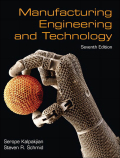
Concept explainers
Summarize the important
Describe the important mechanical and physical properties of plastics.
Explanation of Solution
Plastic is that material which include synthetic or semi synthetic organic compound in large quantity. Also due to the property of malleability, ability to deform under compressive stress, it can change into solid objects.
The important mechanical and physical properties of plastics are discussed below:
- 1) This type of material, plastic, has high corrosion and chemical resistant.
- 2) This type of material, plastic, has low electrical and thermal conductivity.
- 3) This type of material, plastic, has low density rating.
- 4) This type of material, plastic, has high strength to weight ratio.
- 5) This type of material, plastic, has wide range of colors and transparencies.
- 6) This type of material, plastic, is helpful in noise reduction.
- 7) This type of material, plastic, has low cost as compared to other type of similar materials.
- 8) This type of material, plastic, has ease of manufacturing in a wide range of complexities and design possibilities.
Want to see more full solutions like this?
Chapter 7 Solutions
Manufacturing Engineering & Technology
Additional Engineering Textbook Solutions
Foundations of Materials Science and Engineering
Shigley's Mechanical Engineering Design (McGraw-Hill Series in Mechanical Engineering)
Machine Tool Practices (10th Edition)
Degarmo's Materials And Processes In Manufacturing
INTERNATIONAL EDITION---Engineering Mechanics: Statics, 14th edition (SI unit)
Engineering Mechanics: Statics
- Regarding amorphous plastics, explain why they tend to have higher tensile strength when deformed compared to when not. please include an illustrationarrow_forwardwith the use of appropriate diagrams/ structures and examples compare and contrast thermosetting plastics and thermoplastics.arrow_forwardDifferentiate thermoplastics and thermosetting plastics with example materials .arrow_forward
- Describe the features of a screw extruder and its functions in molding of plastics.arrow_forwardWhat factors determine whether polymer behavior is predominantly elastic, viscoelastic, or viscoplastic?arrow_forwardWhat are the two micro-scale plasticity mechanisms active in amorphous polymers? Are they likely to occur simultaneously? Explain.arrow_forward
- Identify a minimum of two structural characteristics and two mechanical characteristics that set elastomers apart from other classes of materials (including other polymers).arrow_forward4ac (simply answer the question) 1.Simply explain the differences between pendant and stiffening groups in polymers. 2. What is glass transition and melting temperature? Simply explain.arrow_forwardExplain how macroscopic plasticity occurs in polymers from the point of view of microscopic mechanisms (covered in the chapters indicated in the Callister book). (maximum of 3 lines, not counting the space for possible schematic figures).arrow_forward
 Elements Of ElectromagneticsMechanical EngineeringISBN:9780190698614Author:Sadiku, Matthew N. O.Publisher:Oxford University Press
Elements Of ElectromagneticsMechanical EngineeringISBN:9780190698614Author:Sadiku, Matthew N. O.Publisher:Oxford University Press Mechanics of Materials (10th Edition)Mechanical EngineeringISBN:9780134319650Author:Russell C. HibbelerPublisher:PEARSON
Mechanics of Materials (10th Edition)Mechanical EngineeringISBN:9780134319650Author:Russell C. HibbelerPublisher:PEARSON Thermodynamics: An Engineering ApproachMechanical EngineeringISBN:9781259822674Author:Yunus A. Cengel Dr., Michael A. BolesPublisher:McGraw-Hill Education
Thermodynamics: An Engineering ApproachMechanical EngineeringISBN:9781259822674Author:Yunus A. Cengel Dr., Michael A. BolesPublisher:McGraw-Hill Education Control Systems EngineeringMechanical EngineeringISBN:9781118170519Author:Norman S. NisePublisher:WILEY
Control Systems EngineeringMechanical EngineeringISBN:9781118170519Author:Norman S. NisePublisher:WILEY Mechanics of Materials (MindTap Course List)Mechanical EngineeringISBN:9781337093347Author:Barry J. Goodno, James M. GerePublisher:Cengage Learning
Mechanics of Materials (MindTap Course List)Mechanical EngineeringISBN:9781337093347Author:Barry J. Goodno, James M. GerePublisher:Cengage Learning Engineering Mechanics: StaticsMechanical EngineeringISBN:9781118807330Author:James L. Meriam, L. G. Kraige, J. N. BoltonPublisher:WILEY
Engineering Mechanics: StaticsMechanical EngineeringISBN:9781118807330Author:James L. Meriam, L. G. Kraige, J. N. BoltonPublisher:WILEY





